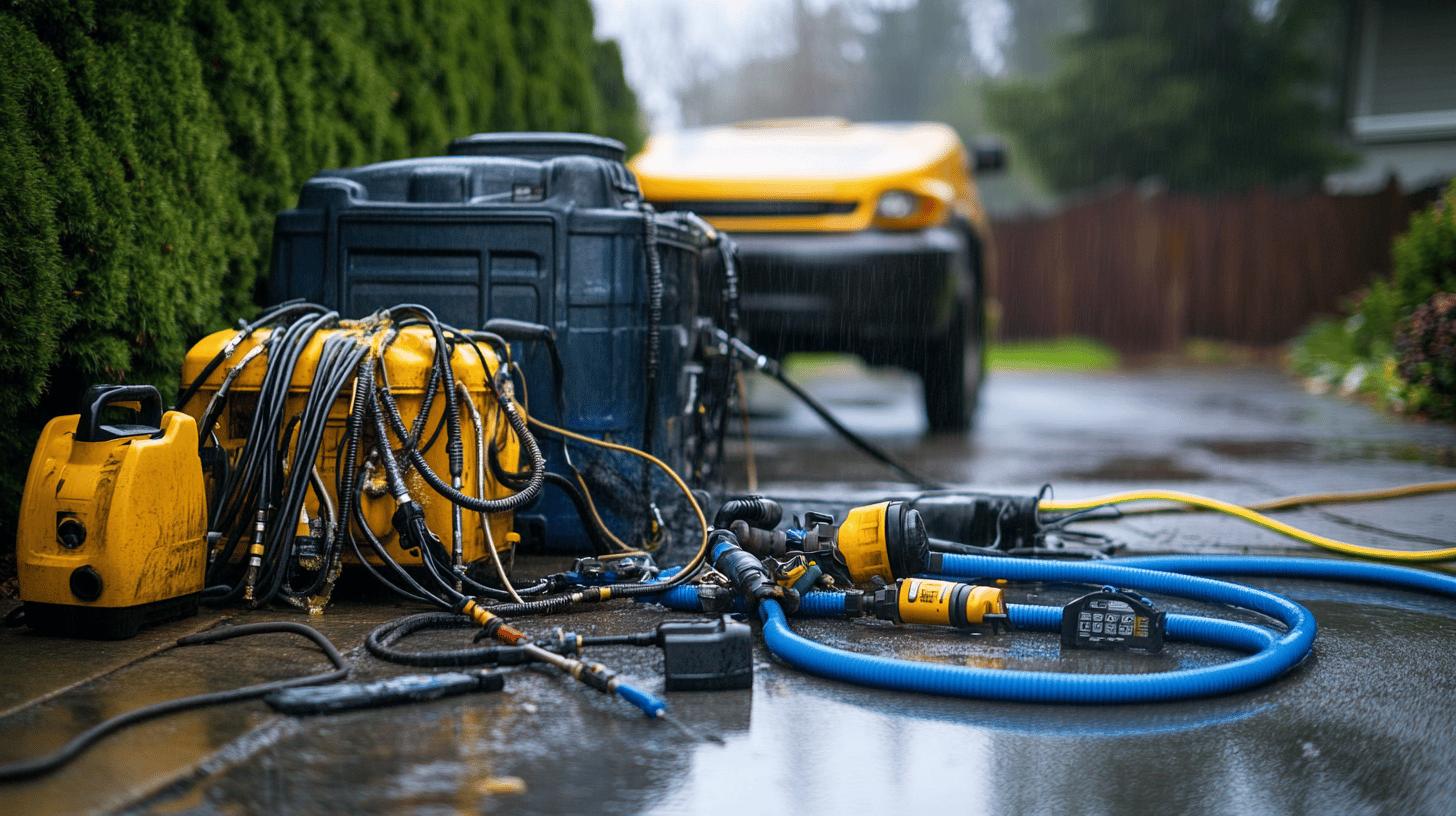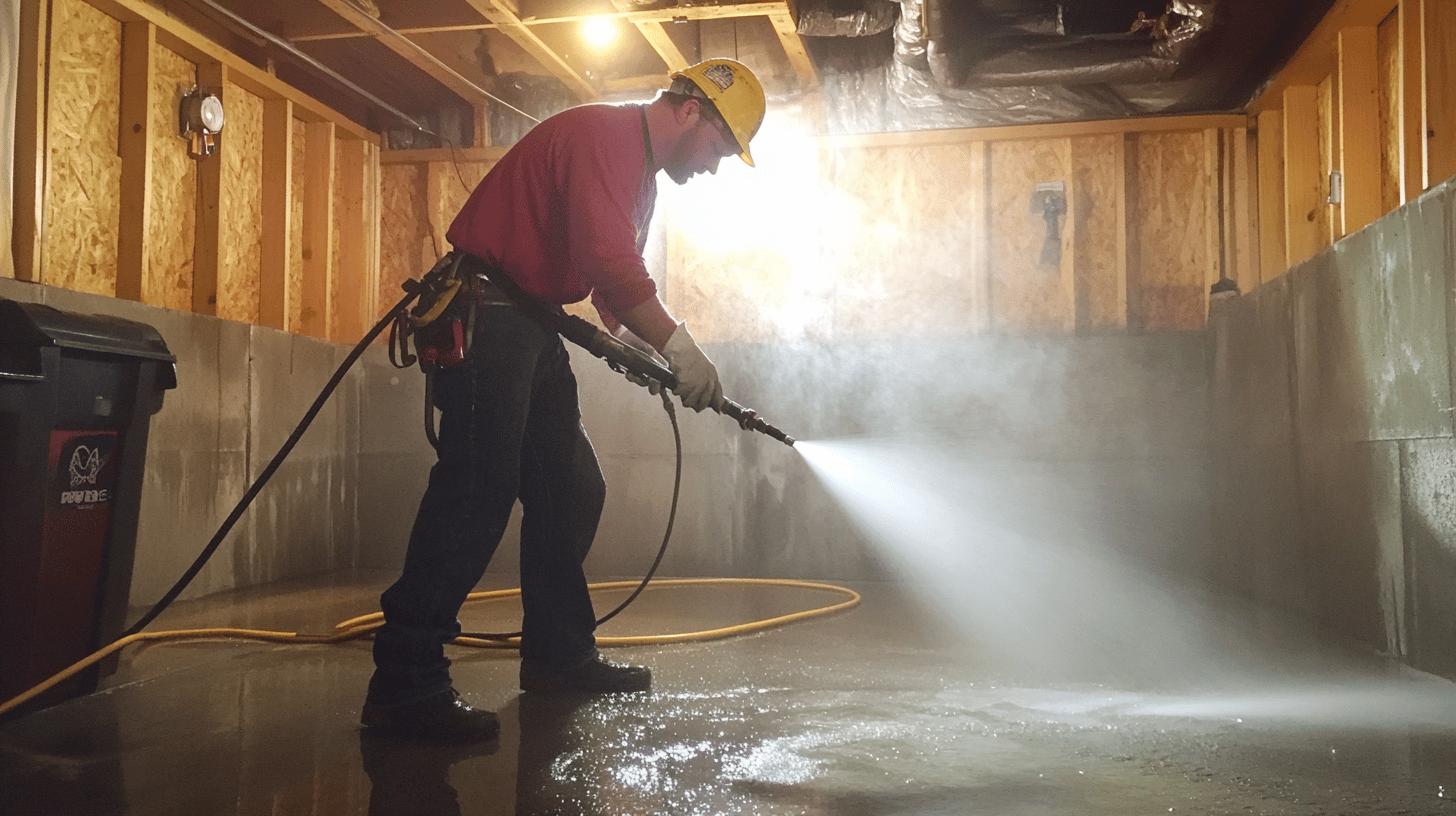TL;DR:
- A pressure washer with a sewer jetter effectively clears blocked drains.
- Essential gear: gloves, goggles; check equipment before use.
- Start with lower pressure to avoid pipe damage.
- Key components of a sewer jetter: 100-foot hose, handles up to 4,000 PSI.
- Use appropriate nozzle for clogs, ensuring smooth hose movement.
- Steps: connect jetter, run water, gently insert nozzle, gradually increase pressure.
- Hire professionals for complex clogs and older plumbing.
- Safety tips: wear protective gear, inspect tools, consult experts for difficult situations.
- Proper use reduces risks and enhances plumbing maintenance.
Ever thought about using a pressure washer for drain cleaning? It might sound unconventional, but it can be surprisingly effective. High-pressure water can help you tackle tough clogs and debris in your drains with ease. In this guide, you’ll learn how to safely and efficiently use a pressure washer to clear your drains, ensuring smooth water flow with minimal hassle. We’ll cover essential safety precautions and step-by-step instructions, so you can harness this powerful tool for routine drain maintenance at home. Let’s dive in!
Understanding Drain Cleaning with a Pressure Washer
Using a pressure washer with a sewer jetter can be an effective way to clear blocked drains. The high-pressure water helps break down debris, making it a popular DIY method. While it works well for typical clogs, it’s important to remember that there are risks involved. Taking the right precautions, like wearing protective gear and knowing when to call a professional, ensures a safe and successful cleaning process.
- Wear protective gear: gloves and goggles.
- Check equipment is working properly.
- Begin with a lower pressure setting.
- Look for any visible pipe damage before use.
- Gradually increase pressure if needed.
Understanding your pressure washer settings is crucial to avoid damaging your pipes, especially older ones. Start with a low pressure setting to minimize risks and check your equipment for any signs of wear or damage before use. Gradually increase the pressure as needed, carefully managing the force to prevent harming your plumbing. By following these steps, you can clean your drains efficiently while protecting your pipes.
Essential Equipment for Pressure Washer Drain Cleaning

A sewer jetter kit for a pressure washer is essential for effective drain cleaning. It transforms your pressure washer into a powerful tool that uses high-pressure water to break up and flush away debris, making it an efficient choice for tackling blockages.
The kit typically includes a high-pressure hose, often about 100 feet long, and designed to handle up to 4,000 PSI. The hose length is important for reaching deep clogs, while the high pressure ensures that debris is cleared efficiently. These features allow you to handle everything from minor clogs to more stubborn blockages.
The kit also comes with different nozzle attachments to suit various cleaning needs. Some nozzles direct water forward to penetrate clogs, while others have backward flow to help move the hose deeper into the drain. This versatility allows you to choose the right nozzle for each specific task, improving your cleaning results.
Step-by-Step Guide to Using a Pressure Washer for Drain Cleaning
Cleaning drains with a pressure washer is a powerful and cost-effective DIY method. By using a sewer jetter attachment, you can harness high-pressure water to break up and remove stubborn debris from your pipes. If done correctly, this method can save you time and money. Here’s how to clean drains safely and effectively with your pressure washer:
-
Connect the sewer jetter to the pressure washer.
- This transforms your pressure washer into a potent drain cleaner by channeling high-pressure water.
-
Run water to ensure a smooth flow.
- Let water flow to check for smooth operation, avoiding sudden pressure changes.
-
Start with lower pressure.
- Begin gently to avoid damaging pipes, especially if they’re older.
-
Insert the nozzle into the drain.
- Place the jetter’s nozzle securely to enhance cleaning.
-
Gradually increase pressure to clear blockages.
- Raise pressure slowly to break clogs without overloading the system.
-
Monitor hose to prevent tangling.
- Watch the hose for smooth movement, avoiding tangles that could disrupt cleaning.
Cleaning drains with a pressure washer can be highly effective, but it does come with some challenges. Managing hose tangles and setting the right pressure are key considerations.
Managing Hose Tangles: If the hose gets tangled during use, stop and carefully untangle it. A tangled hose can cause blockages or uneven water flow. Always make sure the hose is free from any knots before starting the cleaning process.
Setting Proper Pressure: Watch the water flow closely while using the pressure washer. If the flow becomes erratic, this may indicate that the hose is kinked or there’s a blockage in the line. Pause the cleaning process, inspect the hose, and resolve any issues before continuing.
Using a Rotating Nozzle: For better results, consider using a rotating nozzle. This will allow the water to clean all sides of the pipe, providing more comprehensive coverage.
Pressure Control: Always start with a lower pressure setting, especially if you’re cleaning older pipes. Gradually increase the pressure if needed, depending on the severity of the clog. Be sure to keep the nozzle positioned correctly to ensure an even and thorough clean.
By following these tips, you can ensure a smoother, safer drain cleaning process with a pressure washer, maximizing efficiency while minimizing risks to your pipes.
When to Consider Professional Plumbing Services

Sometimes, it’s best to leave drain cleaning to the pros, especially when dealing with complex issues. Clogs caused by tree roots or other tough obstructions require specialized tools and knowledge. Professionals can handle these with ease, ensuring the problem is fully addressed without damaging your pipes.
In older homes, professional plumbers can also check for hidden pipe damage. This can prevent issues from worsening, saving you from costly repairs down the road.
Plumbers use advanced equipment like pressure washers and sewer jetting systems, which are highly effective at clearing buildup and preventing future blockages. Hiring an expert means you get the job done right with minimal risk. Plus, many professionals offer satisfaction guarantees, so you can rest easy knowing your plumbing is in good hands.
Safety Precautions and Best Practices
Safety is crucial when using a pressure washer for drain cleaning, as it prevents accidents and protects your plumbing. To ensure safety, always wear protective gear like gloves and safety goggles to shield yourself from high-pressure water and flying debris. Before using the equipment, check for any damage or wear on hoses, connections, and the pressure washer itself to minimize the risk of malfunctions. Start with a lower pressure setting and gradually increase it to find the right level, especially when working with older pipes. Make sure the hose is free from tangles or kinks to maintain smooth water flow. Also, use the appropriate nozzle for your specific cleaning task to prevent damage to the pipes. By following these safety precautions, you can clean your drains effectively while reducing the risk of injury and plumbing damage.
- Always wear protective gear.
- Inspect equipment for damage before use.
- Start with lower pressure settings.
- Avoid using on older or fragile pipes.
- Seek professional advice for complex situations.
Consulting a professional for drain cleaning enhances both safety and effectiveness. Professionals are equipped to handle complex blockages and can assess potential damage to your plumbing that may be beyond a homeowner’s expertise. Why call a pro? They bring peace of mind by ensuring the job is done correctly, minimizing the risk of further issues. Seeking expert help also preserves the integrity of your plumbing and guarantees reliable, long-lasting results.
Final Words
Using a pressure washer for drain cleaning is a highly effective way to address stubborn clogs. This guide covered everything from attaching a sewer jetter to dislodge debris, to crucial safety measures and the necessary equipment, including nozzles. The step-by-step instructions provided ensure a thorough cleaning process, while also emphasizing when professional help may be needed, striking the right balance between DIY and expert intervention.
By incorporating these insights into your routine, you can keep your drains clear with ease. Remember, with the proper precautions, using a pressure washer for drain cleaning can be both practical and rewarding.
FAQ
Q: What is the best method for drain cleaning with a pressure washer?
A: Using a sewer jetter with your pressure washer is highly effective. It uses high-pressure water to dislodge debris. Start with a lower pressure setting and gradually increase as needed.
Q: How much PSI is needed to jet a drain?
A: A pressure washer with around 1,500 to 4,000 PSI is typically effective for jetting drains. Adjust PSI based on pipe condition and clog severity.
Q: Do high-pressure drain cleaners work?
A: High-pressure drain cleaners are effective in clearing tough blockages. They utilize high-velocity water jets to remove debris and buildup inside pipes, restoring optimal flow.
Q: What equipment is essential for cleaning drains with a pressure washer?
A: Essential equipment includes a sewer jetter kit with a 100-foot hose, a variety of nozzles for different cleaning needs, and a pressure washer capable of handling up to 4,000 PSI.
Q: How do I use a pressure washer to clean drains?
A: Attach the sewer jetter to your pressure washer, ensure water flow, and start on a low pressure setting. Insert the nozzle into the drain, increase pressure slowly, and monitor the hose to prevent tangling.
Q: When should I opt for professional plumbing services instead of DIY drain cleaning?
A: Consider professional services for complex clogs, potential pipe damage, or when DIY methods fail. Professionals ensure safe cleaning and can prevent future blockages.
Q: What safety precautions should I take when using a pressure washer for drain cleaning?
A: Wear protective gear, inspect equipment for damage, and start with low pressure settings. Avoid using on old or fragile pipes and consult professionals for complex situations.

